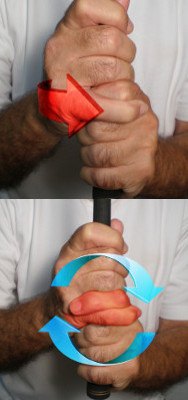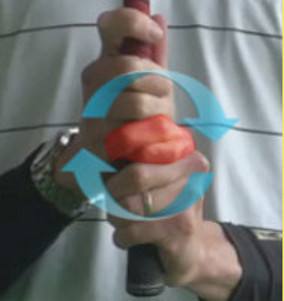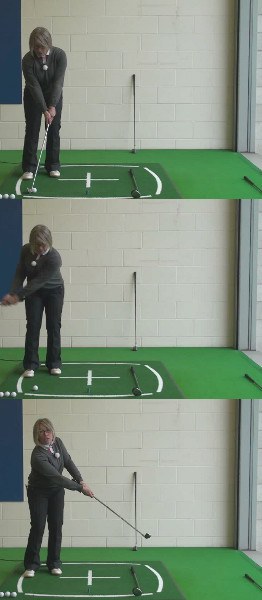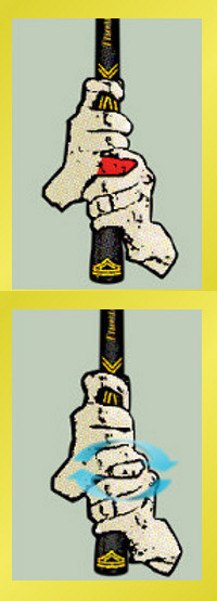
Gripping the club is the most basic act in golf, yet there are many variations in grip styles. The two most common are the interlocking grip and the overlapping (or Vardon) grip. Let’s examine the pros and cons of each.
The interlocking golf grip style finds the right pinky finger locked between the index and middle fingers of the left hand (for a right-handed golfer). Proponents point to its use by Jack Nicklaus and Tiger Woods – arguably the two greatest players in history – as evidence of the interlocking grip’s superiority.
The interlocking grip is widely recommended for players with small hands and/or short fingers (like Nicklaus), as well as beginners and those who lack forearm strength. It’s especially popular among LPGA tour professionals.
The Vardon grip, named for its originator, English legend Harry Vardon, is formed by placing the right pinky finger on top of the seam between the left index and middle fingers. Ben Hogan was among the advocates of overlapping, and it remains the grip of choice for a majority of amateurs and pros.
Overlapping golf grippers believe this style promotes better wrist action and allows a freer, more powerful release of the club through impact.
The bottom line: Test both techniques and go with the one that feels most comfortable.

The Classic Debate of Overlapping Vs. Interlocking Golf Grip
It is true that there are more than two possible ways to hold a golf club. However, for most players, the decision on the style of grip they are going to use will come down to just two choices – either an overlapping golf grip, or an interlocking golf grip. These are the most popular options by far, and the ones that will work best for almost any golfer. They provide the ability to both control the club and swing it quickly through the impact area. Assuming you are already a golfer currently, you probably use one of these two grips right now in your swing.
While both of these grips can work great – and you will see both represented by plenty of players on the PGA Tour – one of them is going to be better for you than the other. Rare is the golfer who is equally comfortable with both of these options, as one typically feels more natural and produces better ball flights. It is your job to explore both of these grips and make sure the one you are using is the right one for your swing.
Before you set out to work on the style of your grip and possibly experiment with the other option, it is important to note that grip changes are notoriously difficult to make within your golf game. Should you come to the decision that you do need to switch from the interlock golf grip to the overlap golf grip, or vice versa, plan on giving that change some significant time to become comfortable and reliable. Patience is a hard thing to have when you are working on a swing change because you want to see instant results, but your progress is likely to come slower in this area. Stick with it, and you should be rewarded in the long run.
There are no hard and fast rules for who should pick an interlocking golf grip, and who should opt for the overlapping golf grip. As you will see below, there are some basic guidelines as to which grip is more likely to work for you based on a number of factors, but even those aren’t set in stone. Your grip is a very personal thing. You might find, for example, that the interlock golf grip just feels perfect to you, even though all signs point to the overlap golf grip begin your better option. Don’t argue with what feels natural, as that will always be your best choice.
The instructions found below are based on a right handed golfer – so be sure to reverse them if you play the game left handed.

The Case for the Overlap Golf Grip
Let’s get started taking a closer look at the overlapping grip. To form this grip around the club, start by placing your left hand on the grip of the club, up towards the top. The shaft of the club should be running across your palm at the base of your fingers – not up your palm towards your wrist. With your left hand grip taken, add the right hand to the grip. To do this, take the pinky finger on your right hand and place it on top of your left hand, in the crease between your second and third finger. As the name ‘overlap’ would indicate, your right hand pinky finger overlaps the pointer finger from your left hand when this grip is complete.
The main advantage to using this grip is the freedom that it offers you within the swing. Your hands should be able to remain relaxed and loose on the club, making it easier to achieve a full release through impact and maximize club head speed. Of course, it is this same ‘loose’ feeling that some golfers don’t enjoy about the overlapping golf grip. If you are looking for a tight and secure feeling around the club, the overlap might not be able to give it to you.
So what type of golfer should consider using an overlapping grip? To start with, it generally works better for a player with large hands. Those with smaller hands may find it difficult to get into a comfortable position with this type of grip, and they may struggle to control the club properly throughout the swing. If you have small hands and still wish to use the overlapping grip, you will want to make sure that the grips on your clubs are small enough to make this possible. Using mid-size or over-sized grips on your clubs will only add to the level of difficulty for players with small hands who wish to use the overlapping option.
Another common feature of a player that is well-suited to the overlap is a smooth golf swing. With such a relaxed grip on the club, sudden changes of direction in the swing are going to be hard to control. If you are a player with a smooth swing that uses tempo and rhythm more than raw power, the overlap could be a good fit. Think specifically about the transition in your swing from backswing to downswing. Is it quick and aggressive, or slow and smooth? Those falling into the ‘slow and smooth’ category will typically be better off with the overlap. However, as mentioned earlier, these are not hard and fast rules – you will have to experiment for yourself to determine which grip actually suits your swing best.
Which grip you ultimately choose says a lot about the way you want to release the club through the hitting zone. Since the overlapping grip takes some of the power away from your right hand in the swing, those who overlap tend to let the club release on its own without much help from the hands and wrists. This is more of a ‘body’ swing, where rotation from the legs and torso are the main drivers of club head release. Using a swing like this can be highly effective and consistent, but it takes many hours of practice if you are used to placing more power in your hands during the swing.
To review, the overlapping grip lends itself nicely to players with large hands, smooth swings, and minimal hand action through impact. Each of these elements of the swing fit nicely with the attributes that the overlapping grip has to offer. If all three of those points happen to match up with your swing, there is a high probability that the overlap is going to work best for you. However, if you only match up on one or two of those points – or none of them – you will want to give the interlocking grip a closer look.

The Case for the Interlock Golf Grip
In order to create an interlocking grip, you are going to start the same way as with the overlap – by placing your left hand comfortably on the club. This time, instead of resting your right hand pinky finger on top of the fingers of your left hand, you are going to ‘interlock’ the pinky finger between your second and third fingers on the left hand. That means that your two hands will essentially be ‘tied’ together by the interlacing of those fingers around the grip. The result is a very secure feeling grip which should provide you with a comfortable hold on the club throughout the swing.
The major benefit of this grip is the security that it provides. When done correctly, your hands should feel securely in place, and they shouldn’t move around much (or at all) during the swing. Many golfers appreciate the secure feeling that the interlock provides so they can swing as hard as they want without feeling like the club might slip in their hands. Because of that secure feeling, there is also a nice sensation of connection between the club head and your hands during the swing.
As you might expect, the interlock is a popular choice among those with small hands due to the security it offers. However, plenty of golfers with larger hands have used this grip as well simply because it feels right to them. Opposite of the overlap grip, the interlock puts plenty of power and control in your right hand at impact, making it possible to aggressively release the club and hit through the ball using your hands and wrists. Depending on the type of golf swing you are trying to make this can be either a good or bad thing.
One important point to make when talking about the interlocking grip is the need to maintain a light grip pressure throughout the swing. Because this grip feels so tight and secure around the club, it is easy to get carried away and squeeze the grip too tightly. A good golf swing requires a light grip pressure to allow the club to swing freely regardless of what type of grip is being used. Make sure that you keep a light grip pressure on the club even when using the interlocking grip so you don’t rob yourself of club head speed by adding tension to your hands and forearms.
We discussed above how a smooth swing is the right fit for an overlap swing. That should make it no surprise that those with a more aggressive swing – especially through the transition – are likely to appreciate the interlocking grip. If you are a player who changes directions quickly at the top of your swing, the interlocking grip should give you the security that you need to keep control over the club during this move.
There is also another variation of the interlock grip that is worth mentioning – the double interlocking golf grip. To achieve this grip, you will interlock your right hand pinky finger between the third and fourth fingers on your left hand. Then, your right hand fourth finger is laced between the pointer and middle finger on your left hand. The double interlocking golf grip is even more secure than the regular interlock, as your hands will be tightly held together. However, there are plenty of problems with this grip. For one, it is difficult to generate proper club head speed due to the complete lack of control in your right hand. Also, the club head feels ‘disconnected’ from the swing and is difficult to control through the hitting area. While you are welcome to experiment with this unusually grip, it won’t be the right choice for most players.
The traditional interlocking grip is going to be a strong choice for players who have small hands, make an aggressive transition in their swing, or simply like to have a secure feeling between their hands and the club. Even if you have never before used an interlocking grip, it is worth the effort to at least hit a few balls on the driving range with the interlock to see how it feels to you.

The Golf Grips Impact on Your Short Game
One often overlooked side effect of a grip chance is the impact that it can have on your short game. Of course, there is no rule requiring you to use the same grip on your short shots as you do with your full swing, but most golfers don’t like to switch back and forth. If you change your grip for the full swing, chance are you are going to want to change your short game grip as well.
With that in mind, is the overlap or the interlock the better choice for short game shots? Well, again, there is no right or wrong answer. Each has its own strengths and weaknesses to be considered. Following are a few advantages to using the overlapping grip on your short game shots
- Rhythm. Having good rhythm in your short game is just as important as it is in your long game, and an overlapping grip should help you toward that goal. This grips tends to be lighter on the club, allowing you to swing it back and forth more easily without too much involvement from your hands.
- Less right hand. An overactive right hand has killed many good short game swings, and the overlapping grip can solve that problem by removing your right hand from the equation. For a basic chip shot, you should find it easier to make solid contact when your right hand isn’t controlling the club quite as much.
- Touch. Again, the softer feel of an overlapping grip is helpful because it should give you a better idea of the touch you need to get the distance right. It is easy to get short shots on line, so distance control is the number one priority when chipping or pitching the golf ball from around the green.
- On the other side of the equation, let’s look at some of the advantages to hitting short game shots using an interlocking grip.
- Control through the rough. This is the top advantage to the interlock when chipping or pitching – being able to control the club face as it moves through the rough. The club will want to twist in your hands when playing from deep rough, so the control that the interlocking grip offers is invaluable.
- More right hand in the bunker. Don’t forget about hitting sand shots as part of the overall equation. While you want to keep your right hand out of most of your short shots, that certainly isn’t true from the greenside bunker. A good explosion shot from the bunker is all about the right hand working the club through the sand, so the interlocking grip should be a big help in this area.
- Calm the nerves. Some of your most nervous moments on the golf course are going to come when you are hitting short shots, and the security that the interlocking grip provides might be of some comfort in those moments. You will feel like you have a firm grasp of the club so you can still hit a good shot even if your hands are a little shaky.
Overall, the impact of your grip on the short game probably shouldn’t have too much to do with which one you end up choosing. Each has their own advantages when it comes to the short game, but you can certainly play quality short shots with either grip. The key to the short game is always putting in enough practice time to get comfortable and confident – and that isn’t going to change regardless of which grip you are using.

Making the Golf Grip Decision
With plenty of information regarding both of these grips now stored away in your head, it is time to get to work deciding which one is going to be right for you. Assuming you already use one of the two grips, you should have a good idea of what that one is capable of. Your job now is to try out the other grip and see if it offers enough advantages to warrant a switch.
To get started, all you need to do is head to your local driving range for a practice session. In order to give your possible grip change the best chance at success, you will want to hit every single shot with the ‘new’ grip during this practice session. So, if you are considering a switch to interlock after years of using overlap, hit all of the practice balls with the interlocking grip. There is a good chance that it will feel quite strange at first, and you may have trouble hitting decent shots. Remain patient, and understand that the results aren’t going to be immediate.
Before you reach for your driver and start swinging as hard as you can, start out with the short clubs hitting shots at only 75% or so of your maximum effort. The grip change is hard enough on its own, you don’t need to complicate things by trying to launch 300 yard drives right off the bat. Get comfortable with your pitching wedge first, then start to move your way through the bag. It make take several practice sessions before you are able to feel comfortable and confident enough to hit full-speed driver shots with this new grip.
So how long should you give the new grip before making a decision? That is going to have to be up to you. It is possible that you feel comfortable with the new grip after only a few practice sessions and a round or two on the course. It is also possible that you never feel right with the new grip and decide to revert back to your old one. Generally speaking, if you still feel completely lost with the new grip after hitting a few hundred shots on the practice range (spread out over a few sessions), you will probably be best served to stick with the grip that you have been using all along. Most amateurs don’t have the time available to spend hitting balls on the range day after day in order to force a grip chance that isn’t coming naturally. You want to use the grip that seems to best suit your swing, and fighting a new grip for too long is a sure sign that it isn’t right for you.
Both the interlocking and overlapping golf grips are great choices. If you watch some professional golf from time to time and pay careful attention to their grips, you will see that plenty of players use either option. Some of the longest hitters on Tour use the overlapping grip, while others use the interlock. Also, among the very best players in the world, there are representatives of both choices. The simple fact that top professionals can be found using both of these grips is a perfect demonstration that each can work for you in your own game. There is definitely no right or wrong in this case – whichever grip feels and performs best for you is the one you should go with. As long as you understand the pros and cons of each option, and put in the necessary practice time to make it comfortable in your game, better golf can be achieved no matter which path you go down.






